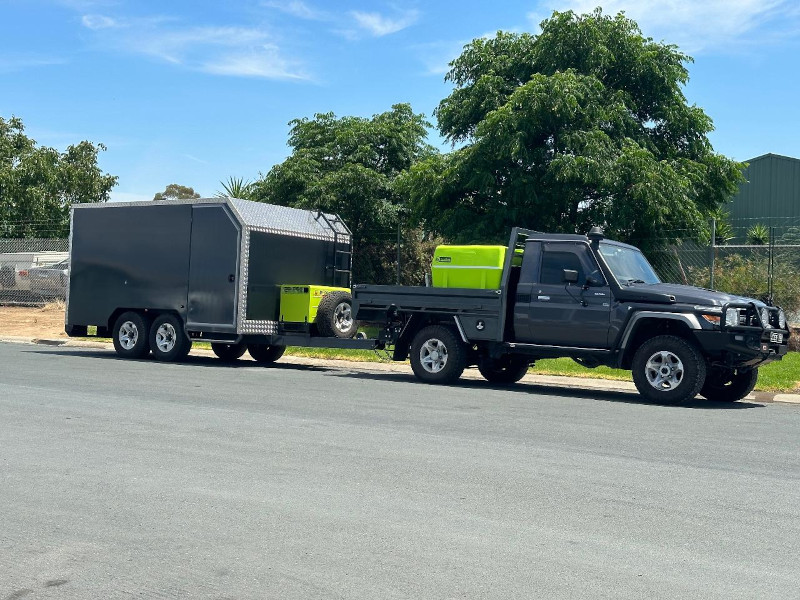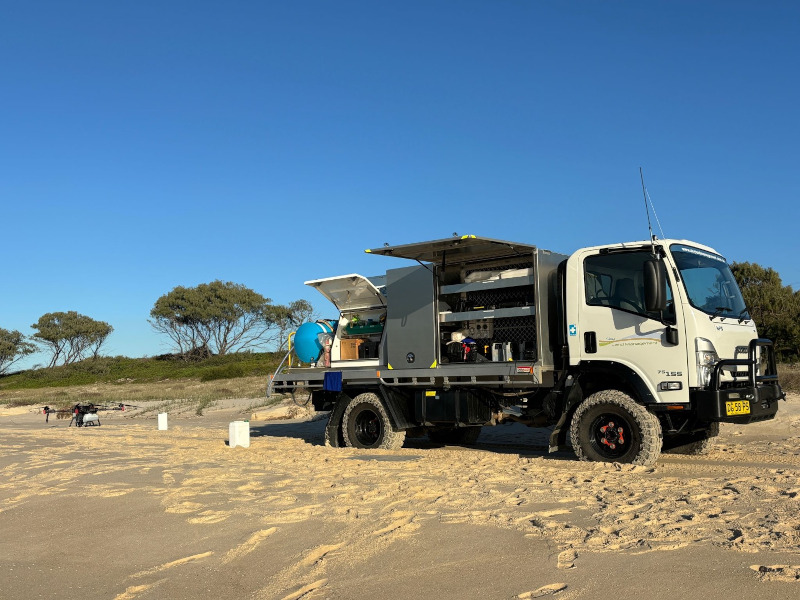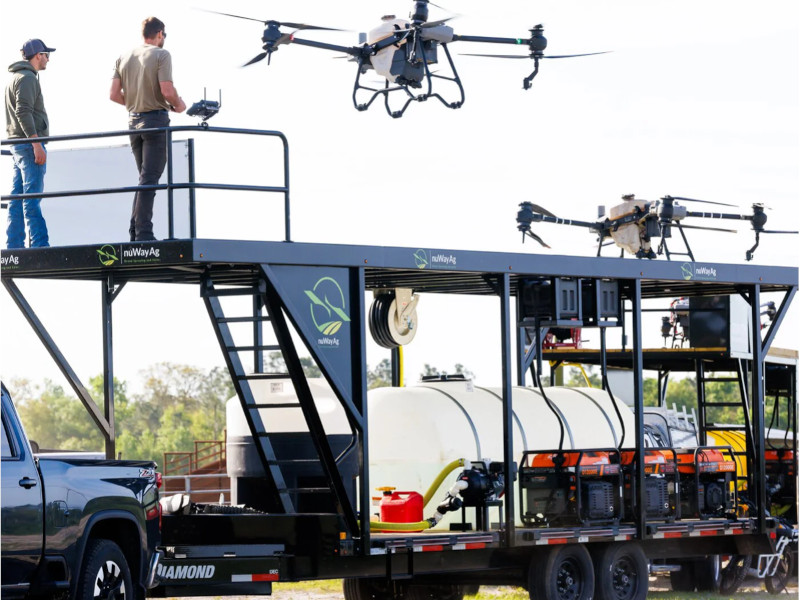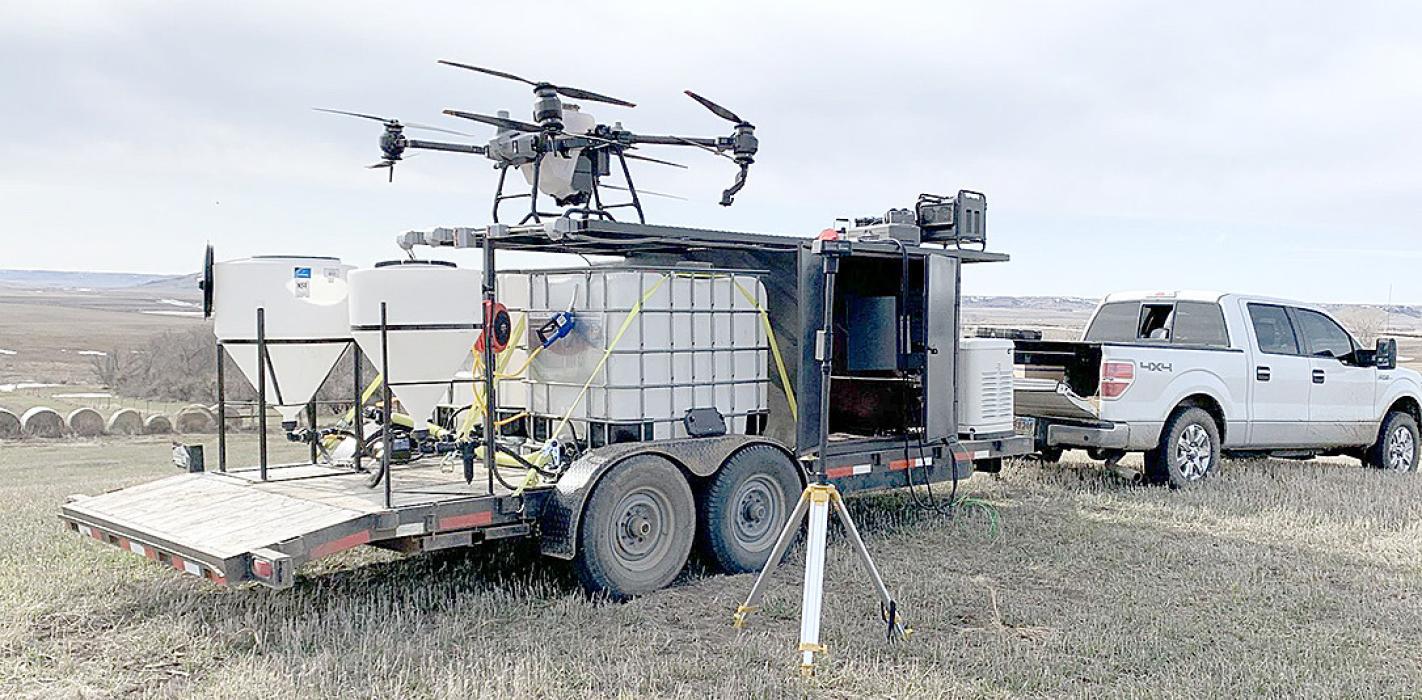In the final article of our series on enhancing spray logistics we make a comprehensive comparison of the three distinct configurations for agricultural drone chemical spray operations.
Introduction
- Ute and Trailer Setup
- All-Inclusive 4×4 Truck Setup
- All-Inclusive Trailer-Only Setup
Each has unique advantages and disadvantages depending on the environment: complex terrain with obstacles versus open broadacre terrain. Let’s explore these setups under both conditions.
Ute and Trailer Setup
Configuration
- Ute: Houses chemical setup for storage, mixing, and handling.
- Trailer: Houses drone equipment, including docking, maintenance, and charging stations.
Pros and Cons in Different Terrain
PROS
- Mobility: Ute is easier to manoeuvre around obstacles and can position near difficult-to-reach areas, enhancing flexibility.
- Separation of Function: Chemical handling and drone management are separate, allowing specialised storage and safer handling in rough areas.
- Adaptability: Trailer can be unhitched and parked, leaving only the ute to move through challenging spots.
CONS
- Dependency on Two Units: Requires towing and unhitching in difficult areas, which can be time-consuming.
- Increased Risk of Getting Stuck: The combined length and weight can make it hard to navigate undulating terrain or mud.
- Higher Fuel and Maintenance Costs: Using two units requires more fuel, which can add up over extensive operations.
Pros
- Efficiency: Trailer can be left in a central location for drone take-offs, while the ute moves to mix and refill chemicals, minimising downtime.
- Increased Capacity: Trailer can hold more drone and maintenance equipment, making it ideal for covering vast acreage with fewer stops.
- Easy Setup: Broad, flat terrain simplifies manoeuvring and positioning, making setup and takedown efficient.
Cons
- Longer Setup Time: The need to position both the ute and trailer can delay initial setup in large, uninterrupted fields.
- Limited Flexibility: In an expansive area, continually moving both ute and trailer can slow productivity, as only one unit operates efficiently when separated.

All-Inclusive 4×4 Truck Setup
Configuration
- Single 4×4 Truck: Contains both chemical and drone equipment, eliminating the need for a trailer.
Pros and Cons in Different Terrain
Pros
- High Mobility: A single, compact vehicle is easier to manoeuvre around obstacles, tight spots, and difficult-to-access areas.
- Simplified Setup: With everything self-contained, there’s no need to unhitch or manage two units, reducing setup and takedown times.
- Reduced Risk of Getting Stuck: Single-vehicle configurations are generally easier to navigate through muddy or uneven terrain.
Cons
- Limited Storage Space: Compact setup limits the amount of chemical and drone equipment that can be stored, which may mean more frequent trips for refills.
- Potential Cross-Contamination: With chemicals and electronics in one space, there is a higher risk of accidental damage or exposure without proper compartmentalisation.
- Higher Cost for Customisation: Modifying a single vehicle for dual functions can be costly, especially if specialised compartments are required.
Pros
- Streamlined Operations: The single truck configuration is efficient in open fields, reducing the need for multiple units and making relocation easy.
- Faster Relocation: With all equipment on board, the truck can quickly move from one area to another, ideal for broadacre spraying.
- Cost-Effective: Operating one vehicle is often cheaper in terms of fuel and maintenance compared to two-unit setups.
Cons
- Limited Operational Range: Smaller storage capacity means more frequent refills, which can slow down operations over large fields.
- Higher Wear and Tear: Combining chemical handling and drone operations in one unit can lead to more intensive use, increasing maintenance needs.
- Reduced Flexibility: In expansive fields, separate units might offer more strategic deployment, whereas a single truck has to balance both tasks simultaneously.

All-Inclusive Trailer-Only Setup
Configuration
- Self-Contained Trailer: Houses both chemical and drone equipment, typically attached to a towing vehicle but capable of serving as a standalone operations base.
Pros and Cons in Different Terrain
Pros
- Base-Station Advantage: Trailer can serve as a fixed operations base in areas with limited vehicle access, with drones launched and retrieved from one central spot.
- Increased Capacity: Trailers often offer more storage than a single vehicle, allowing for larger chemical storage and more extensive drone equipment.
- Reduced Vehicle Traffic: Using the trailer as a stationary base means less movement through delicate terrain, reducing soil compaction or disruption to the area.
Cons
- Limited Manoeuvrability: Difficult to tow a trailer through tight or uneven areas; repositioning can be challenging.
- Dependency on Site Accessibility: Trailer-only setups depend on being able to reach the central location. If terrain becomes impassable, the entire operation is hindered.
- Setup Time: Positioning and stabilising a trailer can take longer in difficult terrain, which reduces overall productivity.
Pros
- Centralised Operations Base: Trailer serves as a stationary hub, reducing travel distances for refills and battery swaps, improving drone deployment efficiency.
- High Storage Capacity: More space for chemicals, batteries, and drones, making it ideal for extended operation in large fields without frequent returns for resupply.
- Cost-Effective: A single trailer unit requires fewer modifications than a self-contained truck, making it a cost-effective option for broadacre fields.
Cons
- Limited Mobility: Trailer must stay in a central area, so operations become more time-consuming if the treatment area is vast and spread out.
- Additional Dependence on Tow Vehicle: Requires a tow vehicle to relocate, and switching locations can take time, especially in very large, open fields.
- Potential Safety Risks: Chemical and electronic equipment are housed in one space, increasing potential for damage or contamination if not organized and stored properly.

Summary Table
| Setup | Complex Terrain (Obstacles, undulating terrain) | Open Broadacre (Flat terrain, no obstacles) |
|---|---|---|
| Ute and Trailer | Pros: Flexible, separate functions, adaptable Cons: Harder to tow, fuel costs |
Pros: High storage, efficient refills, centralised operations Cons: Setup time, limited flexibility |
| All-Inclusive 4×4 Truck | Pros: High mobility, streamlined, reduced setup Cons: Limited storage, customisation costs |
Pros: Fast relocation, cost-effective, easy setup Cons: Frequent refills, wear and tear |
| All-Inclusive Trailer Only | Pros: Centralised base, large storage, less vehicle traffic Cons: Limited mobility, setup time |
Pros: High capacity, central operations, economical Cons: Limited mobility, dependency on tow vehicle |
Conclusion
Each setup has strengths and weaknesses based on the type of terrain:
- Complex Terrain: The all-inclusive 4×4 truck setup offers the best mobility and reduced setup time, making it ideal for navigating obstacles and rough areas. However, the ute and trailer setup provide flexibility, especially when strategically positioned, while the trailer-only setup offers storage benefits but lacks manoeuvrability.
- Open Broadacre Terrain: The ute and trailer configuration shines with its high capacity and efficiency in vast fields, while the all-inclusive trailer-only setup provides an economical, centralised base for large areas. The single 4×4 setup is streamlined and mobile but may require more frequent refills in broadacre settings.
Selecting the ideal setup will depend on the specific logistical needs of the operation and the nature of the terrain, with each configuration providing unique benefits in different farming contexts.

Let’s Get Started
Don’t trust your future to anyone else. FPV Australia have you covered. Contact us NOW!

